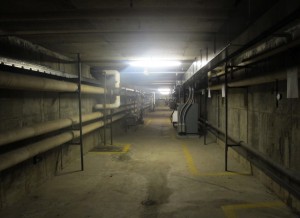Schools See Construction Referenda As Opportunity To Improve Security

Elle Moxley / StateImpact Indiana
Like many Indiana schools built in the 1950s and 60s, Snider High School in Fort Wayne wasn't built with security in mind. The school is getting a newer, safer entrance as part of a district-wide building project.
If voters in Starke County approve a 28-cent tax levy increase Tuesday, students at Knox Elementary will get a new wing — and the district will get a safer, more secure administrative office.
“Right now the superintendent’s office is located in the middle of the school,” says Knox Superintendent A.J. Gappa. “With all the school safety concerns, having the superintendent’s office in the middle of the elementary is not an ideal location.”
Instead, the proposed construction plan isolates Gappa and other administrators on one end of the building, farther from students.
The district isn’t pitching its referendum as a school security upgrade — Gappa says the portion of the elementary flagged for replacement was built in the 1950s and is now out-of-date — but add Knox to a growing list of school corporations using construction referenda to rebuild with safety in mind.
‘Fifty Years Ago … We Didn’t Worry About Security’
Across the state in Fort Wayne, district officials are preparing 49-year-old Snider High School for a facelift. The district is renovating 36 buildings with money from a $119 million referendum that passed last spring.

Elle Moxley / StateImpact Indiana
A series of underground tunnels beneath Snider High in Fort Wayne will give contractors renovating the school easy access to different parts of the building without having to mix with students and staff.
Most of what’s planned for Snider is infrastructure replacement — things like new pipes, new wiring, new doors that will bring the school into compliance with the Americans with Disabilities Act. But the school’s entrance will also be redesigned in an effort to increase safety.
“Fifty years ago when they designed the buildings, we didn’t worry about security, about letting kids, parents, disgruntled anyone walking through the halls,” says facilities manager Darren Hess.
Signs direct visitors to check in at the main office. But once they’ve cleared the door, there’s no mechanism to force them to do so.
“So part of the renovations would be to include a wall here with doors that funnels you into the office,” says Hess. “We can check you in and release you out to the building.”Hess says the construction itself is a security concern — for months he’s been working on a plan to keep students and staff isolated from the outside contractors coming in to renovate the building.
At Snider, a series of underground tunnels connect stairways and corridors. Hess says barriers will go up at access points so the building can be remodeled one hallway at a time.
“Our intent is to completely separate the traffic within the building so we don’t have intermixing of any of the students and contractors because we will have contractors working during the day,” says Hess.
‘I Think It’s Heightened Awareness Because Of Newtown’
Other school districts are planning smaller-scale security upgrades without pursing construction referenda, writes Mikel Livingston for the Lafayette Journal & Courier:
Rossville Consolidated School District has unveiled an approximately $1.3 million plan to upgrade security at the Clinton County district.
Superintendent James Hanna said the move is partly motivated by the Newtown, Conn., shootings last December, in which a gunman killed 26 people at an elementary school.
The improvements also will bring the district in line with existing safety codes through the installation of updated stairway handrails and could recoup some costs through energy efficiencies.
“I think it’s heightened awareness because of Newtown and what went on there,” Hanna said, “and just the concern overall about the safety and security in the building.”
The biggest upgrade would come from about $548,000 put into replacing doors and windows and installing a buzzer security system.
It’s not just in Indiana — across the country, schools are rethinking how to keep students safe. An elementary school being built in Massachusetts will only have classrooms on the second and third floors, putting a stairway between students and a possible intruder. And a Minnesota school district just invested $25,000 in bullet-proof whiteboards.

